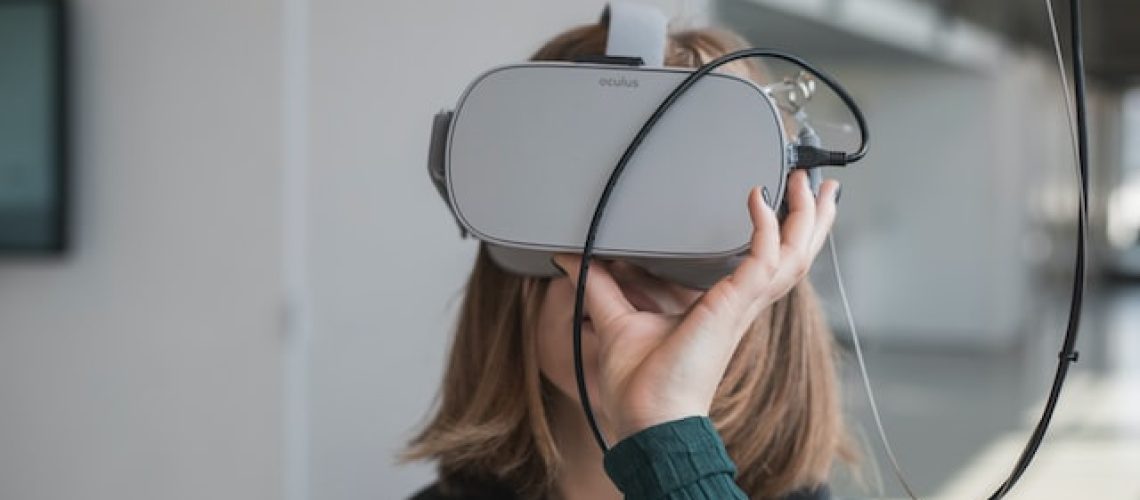VR advertising is a new form of advertising that uses virtual reality technology to create immersive and interactive experiences for users. This technology will soon be working side by side and also integrated in within the likes of Google, Meta (Facebook), SnapChat, Bing et al once people can more affordable access the technology – right now, it’s still astronomically expensive for businesses and end-users and very few have even tried it. It is our prediction however that it will not be long before Google Ads and PPC seem like a seriously retro way of advertising!
These Virtual Reality experiences can be in the form of virtual tours, simulations, or interactive games, and they are designed to engage users and create a more memorable brand experience. Virtual reality advertising has the potential to change the way brands interact with their customers, providing them with a new level of engagement and immersion that traditional 2D advertising can’t match.
One of the most effective ways to use VR advertising is by creating a virtual tour of your physical store or facility. This can help customers get a sense of the layout and atmosphere of your business before they visit in person. By providing an immersive virtual experience, customers can explore your business and get an understanding of what it has to offer without ever having to leave their home. Additionally, virtual tours can also be used to showcase new products or services, giving customers a sneak peek of what’s to come.
Another way to use VR technology for advertising is by developing a virtual reality game or simulation related to your product or service. For example, a car manufacturer could create a VR game that allows users to experience the thrill of driving one of their vehicles. This type of advertising can be particularly effective for products or services that are difficult to explain through traditional advertising methods. A virtual reality experience allows users to interact with the product in a way that is more engaging and memorable than a traditional ad.
In addition to creating VR experiences for customers, businesses can also use virtual reality at events or trade shows to attract attention to their products and services. Offering virtual reality experiences to visitors can be a great way to create a buzz and make your business stand out from the competition. This can be especially effective for businesses in highly competitive industries. Additionally, providing visitors with an immersive experience that they can’t find anywhere else can help create a more memorable brand experience.
Another way to use virtual reality for advertising is by creating virtual reality videos that can be used on social media or other platforms as part of an advertising campaign. Virtual reality videos can be used to give customers a behind-the-scenes look at your business or to showcase new products or services. These videos can be shared on social media, helping to increase brand awareness and engagement. Additionally, virtual reality videos can also be used as part of larger advertising campaigns to create a more immersive experience for customers.
The use of VR can be used as a tool to help customers imagine themselves using your product or service in a way that traditional 2D advertising can’t. With virtual reality, businesses can create an immersive experience that allows customers to see themselves using the product or service in real-life situations. This can help increase brand loyalty and trust, as customers can see how the product can be used in their everyday lives.
Branding, the companies are able to place their brand within the virtual environments, and the audiences can interact with those environments, in this way the brand’s message is conveyed in a more engaging way. This can be a great way for companies to build brand awareness, create a memorable brand experience, and increase brand loyalty.
How Can I Start to Advertise my Business Using VR?
If you’re interested in starting to advertise your business using VR, here are a few steps you can take to get started:
- Research the different types of VR technology and platforms available. There are a variety of different VR platforms that you can use to advertise your business, such as the Oculus Rift, HTC Vive, or Google Cardboard. Each platform has its own strengths and weaknesses, so it’s important to research the options to find the best fit for your business.
- Determine your budget for VR advertising. As I mentioned before, creating a VR experience can be costly, so it’s important to have a clear understanding of your budget before getting started.
- Identify your target audience and the message you want to convey. Determine what type of VR experience will be most engaging and relevant for your target audience, and make sure your message is clear and consistent with your overall advertising strategy.
- Create your VR experience. You can either hire a VR development company or a freelancer to create your VR experience or use some of the VR creation tools available to create the VR experience in-house.
- Test your VR experience. Before launching your VR advertising campaign, make sure to test your experience with a small group of people to get feedback and identify any bugs or issues that need to be addressed.
- Create a marketing plan. Decide where, how and when you want to distribute and promote the VR experience, whether that’s through social media, events, online or offline advertising.
- Measure the performance of your VR advertising campaign. Use analytics tools to track the performance of your campaign and determine if it’s meeting your goals. Based on the results you can then optimise and improve your campaign.
It’s also worth noting that VR advertising is a relatively new and rapidly-evolving field, and it’s important to stay up to date on the latest developments and trends. This may involve attending VR-related events, networking with other VR professionals, or subscribing to industry publications. With the right approach and a clear understanding of your target audience, you can use VR to create engaging and effective advertising campaigns for your business.
Lastly, VR technology can be quite costly to develop and implement, so it may not be the most feasible option for every business. However, for businesses in certain industries such as real estate, automotive, or tourism, VR advertising can be an effective way to connect with potential customers and stand out from the competition. The cost is expected to come down in the future and make it more accessible to small and medium-sized businesses, which will see the adoption rate of VR in advertising increase.
In conclusion, virtual reality advertising offers a new level of engagement and immersion for businesses to connect with their customers. It allows for the creation of immersive virtual tours, interactive simulations and games, virtual events and virtual reality videos that can be used across different platforms. Businesses can use virtual reality to showcase their products and services, create a memorable brand experience, and increase brand awareness and loyalty. While VR technology can be costly to implement, businesses in certain industries may find it to be a valuable investment in standing out from their competitors. As the technology continues to advance and becomes more accessible, we can expect to see more businesses adopt VR advertising as a way to connect with their customers in new and innovative ways.







